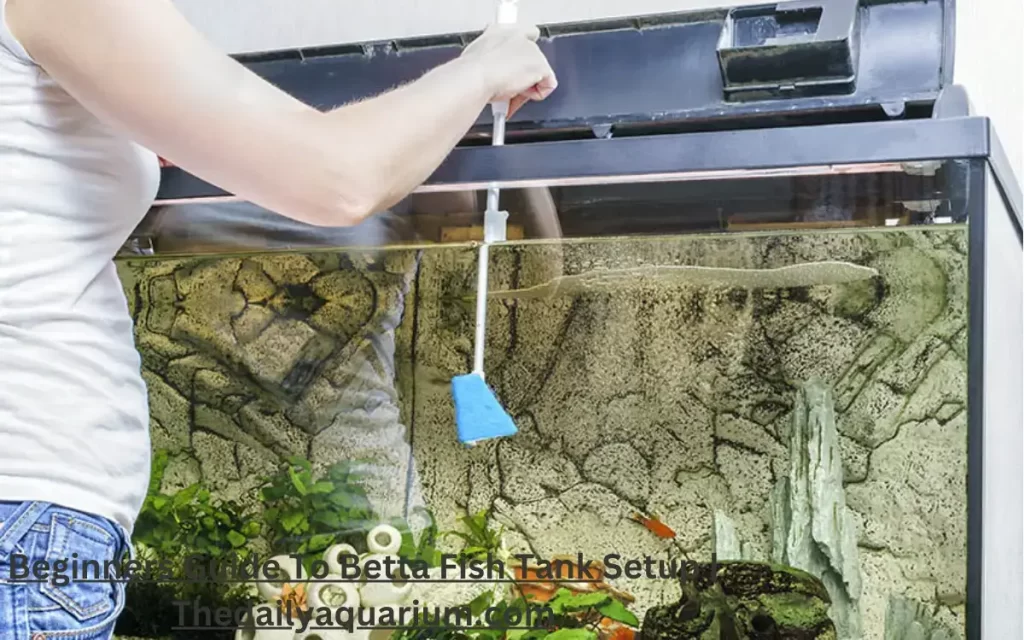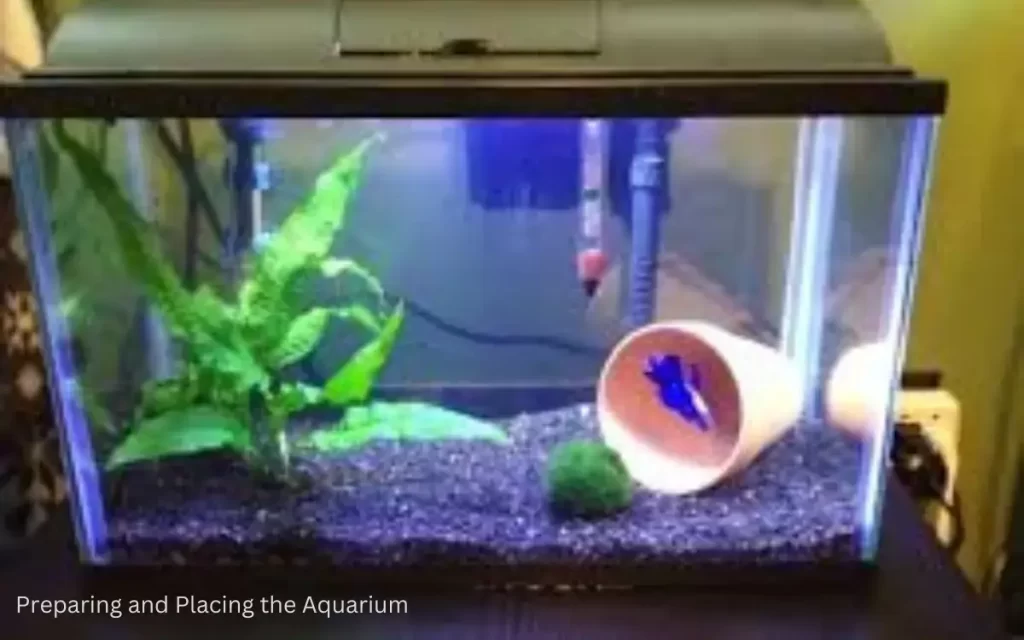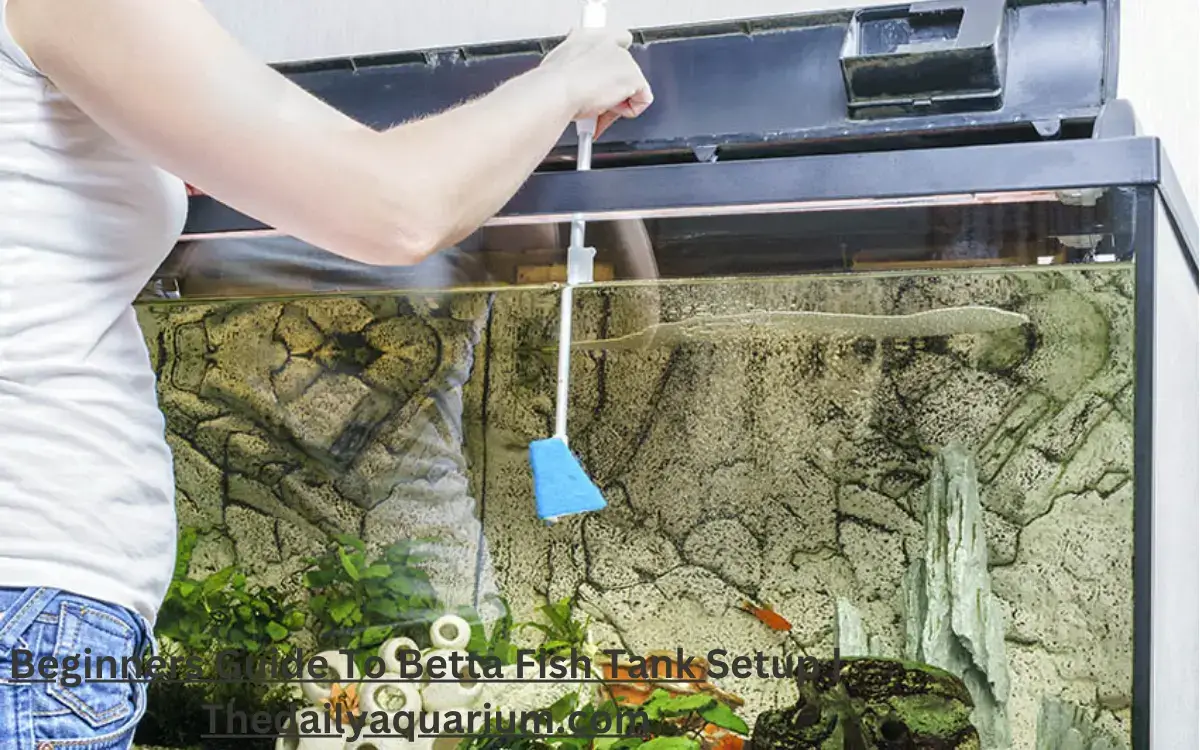
Many people keep betta fish in tiny decorative fish bowls or in bag aquariums so that they can adjust to different environments. While bettas known as fighter fish can survive under such conditions, providing them with ample space and filtered water is essential for their overall well-being and optimal growth.
Betta fish tank setup must be prioritized as far as health and happiness are concerned.
Remember the golden rule: never keep two male bettas together, as they will engage in deadly fights. It is recommended to provide a minimum tank size of 5 gallons for a betta fish.
This article provides insight into how to set up an optimal tank for your beloved betta. Find out how a well-designed habitat can enhance your fish’s well-being and aesthetic appeal, ensuring your fish thrives.
Here are some things to remember for beginners,
The use of tiny aquariums or vases is not recommended for Betta fish. These setups cause rapid water pollution and restrict the fish’s movement, which can be both harmful and cruel. Betta fish can survive in small spaces, but it does not promote their happiness or well-being. Give them a better quality of life!
What makes for a cool Betta tank?
A cool Betta tank must have ample space, effective filtration, and appropriate heating for the fish to be comfortable. The aesthetic appeal of your aquarium can be enhanced with live plants, decorations, and compatible tank mates. A healthy and vibrant Betta tank requires regular maintenance and water quality monitoring.
Table of Contents
How to Choose a Tank and Accessories

Step 1. Choosing Your Betta Fish Tank and Accessories
1. How to Pick a Betta Fish Tank: It’s All About Size!
There’s no way betta fish can thrive in those tiny plastic bowls you find in stores. These vibrant creatures require ample space to thrive. The best tank for your betta is one with a capacity of at least 2.5 gallons (9.5 L), although 5 gallons or 10 gallons are better.
You should always include a lid in your betta aquarium setup as they are more likely to jump. Such a large tank offers several advantages. It allows for safe water heating, reduces the risk of contamination, and facilitates the setup of the aquarium nitrogen cycle.
Furthermore, bettas cannot coexist with other bettas. While the idea of a female betta “sorority” has gained attention, it is considered unethical and unnatural. It’s worth mentioning that female betta fish tank setups should only be attempted by experienced owners.
The best approach is to house each betta separately, meaning you’ll need a dedicated tank for each male or female betta you own. This approach ensures a stress-free life for your pet.
2. Should I Consider the Tank Material?
Betta fish owners often choose tanks that are made of glass or acrylic because it is durable and attractive. Their smooth surfaces make it easy to remove algae and debris, ensuring a visually pleasing and hygienic environment for your betta fish.
It ensures not only a visually stunning display but also a low-maintenance aquatic environment for your cherished aquatic companion.
3. Do I Need a Filter for My Betta Fish?
You need a filter for your betta fish tank to maintain cleaner water. However, bettas do not prefer strong water currents.
Follow the instructions provided in the manual when setting up the filter. Ensure the device is functioning properly and monitor the flow of water to prevent a strong current. You can reduce the current with buffers, such as plants or cut water bottles if your filter is more powerful.
A filter is essential for bettas (and all betta fish in aquariums) since it plays an essential role in the nitrogen cycle. If you install a filter to prevent the accumulation of toxins in the water, your fish will be healthy and safe.
4. Does a Betta Fish Need a Heater?
Betta fish, being tropical fish from Thailand, need a heater in their aquarium for survival and health. It may sound unusual, but it is a necessary component to provide the ideal conditions for them.
It is important that if your tank is smaller than 5 gallons, it is not recommended to include a heater. However, as previously mentioned, it is advisable to avoid keeping Betta fish in tanks smaller than the recommended size. Therefore, if you follow the appropriate tank size for Bettas, a heater becomes an essential requirement.
I suggest investing in a fully submersible heater that can maintain the water temperature between 78 and 80 degrees Fahrenheit. It is preferable to choose a heater that includes a thermostat for better temperature control.
Regular monitoring of the tank’s temperature is crucial to ensure consistent water conditions and the well-being of your Betta fish. Whenever possible, use a separate thermometer instead of the one built into heaters, since they are not always accurate.
Betta fish can suffer adverse effects from temperature fluctuations. A sudden drop in temperature can make them susceptible to diseases like Ich, while excessively high temperatures can accelerate the aging process and significantly shorten their lifespan.
Therefore, constant temperature monitoring is necessary. While Betta fish are generally easy to care for, it is essential to pay attention to these small details and maintain consistent tank conditions to ensure their overall well-being.
5. Selecting Suitable Gravel for Your Betta Fish Tank Set up
You must choose the right gravel for your betta fish tank set up to ensure its safety and thriving. Small or smooth gravel works well for Betta fish, which are active swimmers that explore the tank’s bottom often. Keep their fins and scales protected by choosing small or smooth gravel.
In the tank ecosystem, gravel serves as a surface for beneficial bacteria to grow, which is important for the tank’s health. Gravel with large rock pieces can create crevices where food particles and waste can accumulate, negatively affecting your betta fish’s health.
Ideally, your tank should have a gravel layer of at least two inches if you wish to include live plants. This depth allows the plant roots to establish and thrive. However, if you prefer using fake plants made of silk, a gravel layer of one inch is sufficient.
6. Selecting Plants and Decorations
Bettas belong to Thailand, where they live in shady areas such as rice paddies, streams, and large puddles. They will feel comfortable and happy if you provide them with decorations like caves and plants that mimic their natural surroundings.
Whenever selecting ornaments for your aquarium, look for sharp or jagged edges that could potentially harm your Betta’s delicate fins.
A live or silk plant will be a great addition to your Betta’s habitat as Bettas love to lie on leaves and have places to hide and sleep. You should use silk plants instead of plastic ones, which can harm your fish.
Betta fish can become bored and depressed if they lack stimulation if decorations are not rearranged regularly.
It is easy to create a safe and comfortable environment for your Betta fish tank setup by choosing appropriate plants and decorations. Keep in mind your fish’s needs and provide them with a natural and stimulating environment for them to thrive.
7. Lighting for Your Betta
Lighting is an important factor to consider when caring for Betta fish. In the same way that humans prefer a regular schedule of light and dark, Betta fish do as well. You should consider investing in aquarium lighting if the aquarium you choose does not have it.
You can help your Betta stay healthy and happy by providing it with a regular schedule of light.
LED lights are a great choice for your Betta fish tank since they allow you to easily control the intensity of the light, which is important since Bettas don’t like bright lights. Furthermore, LED lights come with automatic timers, so you can set the lighting schedule and not worry about it again.
Step 2: How to Setup Your Betta’s Tank

1. Preparing and Placing the Aquarium
You should choose a secure area in your home when setting up a betta aquarium. Choose a location near a window, but keep the tank away from direct sunlight, which can cause temperature fluctuations and algae growth.
The surface where the tank is placed should also be sturdy to prevent any spills or accidents. If you have other pets in the house, it’s a good idea to consider placing the betta in a room where they don’t have access to, it to avoid any potential issues.
To provide the necessary support for your tank, you may want to invest in an aquarium stand designed to hold the weight of your tank. When positioning the tank, make sure to allow at least 5 inches of space between the back of the aquarium and the wall.
This space will accommodate the filter and heater, ensuring they have enough room to function correctly. By choosing a suitable location for your betta tank, you’ll create a safe and stable environment for your fish to thrive.
2. Install Your Filter
The installation process for different types of filters may vary, so it’s important to consult the manufacturer’s instructions specific to the filter you have purchased. For external power filters, position the filter at the back of the tank. Some tank lids come with a cut-out designed to facilitate installation.
I would recommend waiting until the tank is filled with water before turning on the filter to prevent any potential damage.
If you have an under gravel filter, start by placing the filter plate at the bottom of the tank. Ensure that the tubes are correctly fitted and positioned. It is important not to turn on the filter until the tank has been completely filled with water
By carefully following the instructions provided by the manufacturer and properly installing the filter, you can ensure its optimal functionality and contribute to a clean and healthy environment for your betta fish.
3. Add Your Gravel
To prepare your betta fish tank for gravel, it is essential that you clean it thoroughly with cool running water before adding it. This step is important to remove any dust or debris that could potentially clog your filter system. You should, however, keep in mind that using soap can be harmful to your betta fish.
Once the gravel has been rinsed and cleaned, you can proceed to add it to the tank. The amount of gravel you add will depend on the type of plants you plan to incorporate into your tank. If you’re using real plants, it is recommended to have a gravel layer of at least two inches.
This provides enough depth for the plant roots to establish and thrive. On the other hand, if you’re using silk plants, a gravel layer of one inch will be sufficient. You can ensure that you have created a suitable and attractive substrate for your betta fish tank by following these steps.
4. Set up Your Plants and Decorations
Once you have selected and prepared your plants and decorations, it’s time to set them up in your betta fish tank. If you are using live plants, ensure that the roots are properly buried beneath the surface of the substrate.
It is important to arrange the planted areas so that the taller ones are at the rear of the tank, while the shorter ones are at the front. This arrangement will not only provide an aesthetically pleasing display but also allow for a clearer view of your betta fish.
When placing decorations, such as caves or ornaments, it is important to anchor them securely in the gravel. This will prevent them from coming loose and potentially causing harm to your betta fish or disrupting the tank environment.
After you have filled your tank with water, avoid putting your hands back in the water. This is because repeated disturbances can disrupt the water balance and potentially stress your betta fish. Therefore, take a moment to carefully assess the positioning of your plants and decorations to ensure that you are satisfied with their arrangement.
5. Fill it up!
Now it’s time to fill your betta fish tank with water. Place a plate on top of the gravel and gently pour water into the tank, allowing it to gradually fill the tank. This will prevent the gravel from becoming displaced. If you are filling a tank, be on the lookout for signs of leaks or water seepage to ensure that the tank is water-tight.
When filling the tank, leave an inch at the top. The reason is that bettas have a labyrinth that enables them to breathe atmospheric air since they’re anabantoids. Your betta needs access to the surface to breathe air, which is critical for their overall health and well-being, so leaving a gap at the top of the tank is a wise choice.
Additionally, bettas are known for their jumping ability, so it is important not to fill the tank to the brim. Filling the tank completely could put your betta at risk of jumping out of the tank and injuring itself. Therefore, maintaining a slight gap between the water level and the top of the tank is a safety precaution to consider.
Once you have finished filling the tank, remember to remove the plate that was used to prevent gravel displacement. This will ensure that the tank is properly filled and ready for your betta fish to inhabit.
6. Turn on Your Filter and Install Your Heater
It’s time to turn on your betta fish tank’s filter after the water has been filled up. Make sure the water circulation is gentle, smooth, and quiet. It is beneficial to have an adjustable filter in this case, as it allows you to customize the water movement according to your betta’s preferences.
The next step is to attach your heater to the aquarium. Most heaters include suction cups that can be used to attach them. Follow the manufacturer’s instructions to properly position and secure the heater.
Set the temperature on the heater to maintain a range between 78 and 80 degrees Fahrenheit, which is optimal for bettas. To keep track of the temperature, place a thermometer in the tank at a convenient location where it can be easily monitored.
After the filter is running smoothly and the heater is set up, double-check that everything is working properly and that the tank conditions are suitable for your betta fish. You can now remove the plate that was used during filling to prevent gravel displacement.
When you turn on the filter, adjust it as needed, and set the heater at the correct temperature, you will be ensuring your betta has a healthy and enjoyable aquatic environment. You can maintain optimal conditions for the well-being of your fish by monitoring the temperature regularly.
7. Add Neutralizer and Perform a Fishless Cycle
Whenever you fill your aquarium with tap water, it’s important to check for chlorine. The water in your tap usually contains chlorine, which can harm your betta fish. You should add a neutralizer according to the instructions included with the product to remove the chlorine effectively.
Because chlorine interferes with the fishless cycle, this step is essential. Establishing a healthy environment for your betta fish starts with the fishless cycle. The process involves the development of beneficial bacteria in your tank and filter media.
In the nitrogen cycle, these bacteria convert toxic substances into less harmful compounds. During the fishless cycle, ammonia (toxic) is converted into nitrite (toxic), and then nitrite is further transformed into nitrates (non-toxic).
The fishless cycle ensures that the beneficial bacteria are established in your tank before adding your betta fish. This cycle allows the bacteria to effectively neutralize the waste produced by your fish, maintaining a safe and healthy environment for them to thrive.
Your actions will create a suitable and stable ecosystem for your betta fish by removing chlorine and performing the fishless cycle.
Step 3. Introducing Your Betta

1. Buying Your Betta: How to Choose a Healthy Betta
If you intend to keep a betta fish for a long time, make sure it is a healthy one. Here are some tips for selecting a healthy betta:
Active and Alert: Look for a betta that is active and alert, swimming around its container or tank. Avoid bettas that appear lethargic, float aimlessly, or show signs of illness.
Vibrant Colors: Healthy bettas have vibrant and bright colors. Avoid bettas with faded or dull colors, as it may indicate poor health.
Intact Fins: Check the betta’s fins for any signs of damage or tearing. Healthy bettas have intact and undamaged fins.
Clear Eyes: The betta’s eyes should be clear and free from any cloudiness or signs of infection.
Smooth Scales: Examine the betta’s scales to ensure they are smooth and without any bumps, sores, or discoloration.
Breathing and Movement: Observe the betta’s breathing. It should be regular and not labored. The fish should swim with ease, without struggling or gasping for air.
You can provide a happy and thriving home for your new fish companion by choosing a healthy betta.
2. Finally Introduce Your Betta to its New Tank
The first time you introduce your new Betta to its new home, it will probably end up in tears. You need to acclimate it to its new environment.
You’ll get your Betta in a bag of water, which is different from the water in your aquarium. Float it in the aquarium for a few minutes until the bag’s temperature matches your aquarium’s.
When your betta bag is floating, keep it closed so that it does not leak. It usually takes around one hour for the water in the bag to adjust to the temperature of the tank water.
When the temperatures have equalized, start adding small amounts of tank water to the bag regularly. This helps the betta adjust to the differences in water parameters, such as pH levels.
Your betta can gradually be released into the tank as the majority of the water in the bag is replaced with tank water. The fish can now swim freely in its new environment after you open the bag.
By acclimatizing your betta to the tank water, you reduce the risk of temperature shock and allow the fish to adjust comfortably. This method promotes a smoother transition and helps ensure the well-being of your betta in its new home.
Final Words on How to Setup a Best Betta Fish Tank
As soon as you know how to set up your Betta fish tank correctly, you’ll need to provide appropriate care for them. Make sure your Betta fish get Betta-approved food once a day, and don’t overfeed them. Weekly water changes of 20% are recommended to maintain a healthy environment. pH, ammonia, and nitrate levels should be monitored regularly, and issues should be resolved as needed. You should clean your tank regularly, especially if you have a filter. Follow this guide to keep your Betta fish happy and vibrant for years to come.








